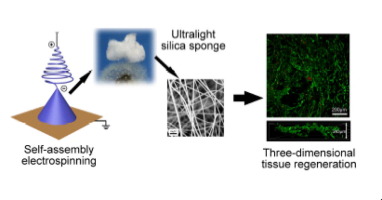Chemical Engineering Journal ( IF 13.3 ) Pub Date : 2017-09-07 , DOI: 10.1016/j.cej.2017.09.020 Hao-Yang Mi , Xin Jing , Brett N. Napiwocki , Zhu-Tong Li , Lih-Sheng Turng , Han-Xiong Huang

|
Fabrication of highly porous, three-dimensional (3D) scaffolds with biomimicking microstructures for tissue engineering has received extensive attention lately. Although several studies have used silica as a filler material in various polymeric scaffold matrices for tissue engineering, there are no reports of 3D scaffolds fabricated solely with silica. In this study, we developed a method to fabricate fibrous silica sponges using a tetraethyl orthosilicate (TEOS)/polyvinyl alcohol (PVA) solution via self- assembly electrospinning and subsequent calcination. We then evaluated its potential application in tissue engineering. A detailed mechanism study revealed that appropriate crosslinking between hydrolyzed TEOS and PVA was the key to inducing 3D fiber stacking. The prepared silica sponges had a bulk density of 16 mg/cm3, a surface area of 6.45 m2/g, and a porosity of 98%, which endowed them with super-high absorbability. Cell culture results with 3T3 fibroblasts confirmed that the cells interacted strongly with the 3D silica fibers, showing a higher viability and proliferation rate than on 2D silica membranes, and that the cells migrated into the inner area of the sponge rapidly, indicating these silica sponges have potential to be used for 3D tissue regeneration.
中文翻译:

自组装静电纺丝法制备二氧化硅纤维海绵及其在三维组织再生中的组织工程应用
具有用于组织工程的仿生微结构的高度多孔的三维(3D)支架的制造近来受到广泛关注。尽管数项研究已在各种用于组织工程的聚合物支架基质中将二氧化硅用作填充材料,但尚无关于仅用二氧化硅制造3D支架的报道。在这项研究中,我们开发了一种通过自组装静电纺丝和随后的煅烧过程使用原硅酸四乙酯(TEOS)/聚乙烯醇(PVA)溶液制造纤维状二氧化硅海绵的方法。然后,我们评估了其在组织工程中的潜在应用。详细的机理研究表明,水解的TEOS与PVA之间的适当交联是诱导3D纤维堆叠的关键。制备的二氧化硅海绵的堆积密度为16mg / cm 3。表面积为6.45 m 2 / g,孔隙率为98%,具有超高吸收性。3T3成纤维细胞的细胞培养结果证实,细胞与3D二氧化硅纤维发生了强烈的相互作用,显示出比2D二氧化硅膜更高的生存力和增殖率,并且细胞迅速迁移到海绵内部,表明这些二氧化硅海绵具有用于3D组织再生的潜力。































 京公网安备 11010802027423号
京公网安备 11010802027423号